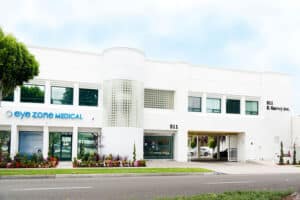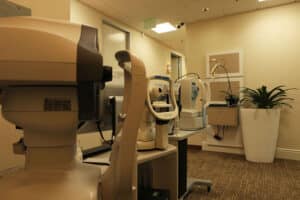Over the years, there have been numerous advances in the technology for removing cataracts. These improvements have made cataract treatment surgery one of the safest procedures performed today, and have significantly shortened the recovery time. Millions of people undergo this vision-improving procedure every year and experience excellent results.

Am I a Good Candidate for Cataract Surgery?
- The visual effects of cataracts interfere with your everyday life.
- Poor vision keeps you from safely driving or doing your job.
- You can no longer watch television, read or enjoy your favorite hobbies.
- You feel less independent.
- It’s difficult to take medication or attend doctors’ appointments.
Cataract Surgery Procedure
Cataract surgery is usually performed one eye at a time and takes less than 30 minutes to complete.
- First, a small incision is made on the upper part of the eye.
- Then, the old, cloudy lens is removed.
- An artificial intraocular lens (IOL) is implanted.
Cataract surgery is a quick and generally painless procedure that takes place on an outpatient basis under local or eye drop anesthesia. Once you decide to undergo surgery, you will need to schedule an appointment with your primary care physician (PCP). Your PCP will perform laboratory exams and give you clearance to undergo cataract surgery.
Once you have clearance, you will see our Cataract Surgeons for your pre-operative appointment. Here, the surgeons will perform multiple exams in order to get your proper lens measurements. You will need to arrange transportation to and from the surgical facility for the day of surgery. You will also need to begin your eye drop treatment one day prior to surgery. Patients should stop eating and drinking after midnight the night before surgery. You can eat and drink again after surgery.
At our East Los Angeles LASIK surgery center, the procedure should take 30 minutes or less to complete. Vision recovery can be almost as rapid as with LASIK; many patients are able to see well enough to drive within a few days.
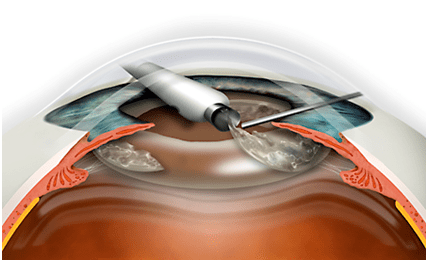
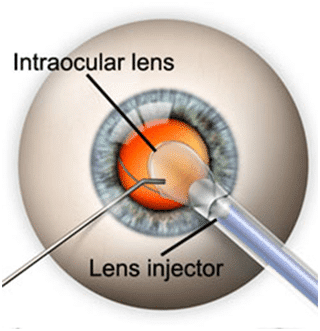
Cataract Removal Process
- A tiny incision is made on the upper part of the eye.
- Through this incision, the surgeon inserts an instrument called an ultrasonic probe into the eye to break up the cataract into small pieces, then gently “vacuums” the pieces out.
- Your cataract surgeon will implant an artificial intraocular lens that will replace your eye’s natural lens.
- A stitch may be required to close the incision; this varies from patient to patient.
- Your eye will be patched when the surgery is complete.
Ready to Schedule an Appointment?
We are committed to helping you achieve your visual goals and guarantee that we will safeguard your interests at all times.
Expectations following cataract surgery
Most patients typically return home the very same day after the surgery. Eye drops will be prescribed to guard against infection and help your eye heal. You should remove the eye patch as soon as you get home after surgery so that you can continue to use your drops as directed by Cataract Surgeon. For a few days, you will need to wear an eye shield while you sleep to keep away irritants and prevent you from touching or hurting your eye while sleeping. Everyone heals differently, but most patients see well enough to return to most of their routine activities within a few days after surgery.
Cataract Treatment Follow-Up Care
Your post-operative care is just as important to your recovery as the procedure itself. It is important that you use your eye drops as prescribed and keep all scheduled follow-up appointments. Our trusted medical team will closely monitor your recovery. We are available to answer any questions or concerns you may have during your process.
Post Operative Restrictions
- No driving for at least 24 hours
- Do not sleep on the operated side for 1 week
- No heavy lifting or bending over for 1 week
- No eye makeup or lotions for 1 week
- No aerobic activity for 1 week
- No swimming or hot tubs for 1 month
- No contact sports for 1 month
- No eye rubbing for 3 months (but you should break this habit anyway)
About Cataracts

A cataract is caused by a clouding of the natural lens inside the eye. Normally, light rays are focused through your lens and onto the retina, a layer of light-sensitive cells in the back of the eye. Over time, the lens can become cloudy and prevent light rays from reaching the retina. The result is blurry or distorted vision. Cataracts generally develop slowly and painlessly. In fact, you may not even realize that your vision is changing. In its early stages, vision blurred by a cataract can be improved with glasses or contact lenses. However, it is important to note that glasses, contact lenses, dietary changes or laser treatments cannot make the cataract go away. The only way to remove a cataract is through surgery.
Over the years, there have been numerous advances in the technology for removing cataracts. These improvements have made cataract treatment surgery one of the safest procedures performed today, and have significantly shortened the recovery time. Millions of people undergo this vision-improving procedure every year and experience excellent results.
Cataract Symptoms
Vision loss with cataracts is gradual, progressive and painless. Often, vision with cataracts has been described as seeing life through an old, cloudy film. Patients will notice that the use of glasses will not reverse the effects of their cataract.
Symptoms of Cataracts
- Difficulty driving
- Difficulty seeing at night
- Difficulty viewing a computer screen
- Colors appear dim and faded
- Frequent change in glasses prescription
- Blurry, double, or distorted vision
Certain types of cataracts affect distance vision more than reading (near) vision, while others affect reading vision more than distance vision. As cataracts worsen, people with farsightedness (hyperopia) may see an improvement in their distance vision and become less dependent on glasses. However, people with nearsightedness (myopia) may see their distance vision worsen. Other types of cataracts cause significant glare, making night vision poor even in the early stages.
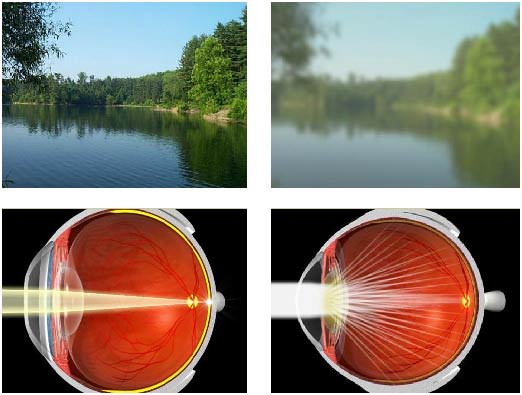
What Causes Cataracts?
Cataracts are a result of aging. Other possible causes include trauma to the eye, overexposure to ultraviolet light or as a result of taking certain medications such as corticosteroids. Cataracts can also develop as a result of a systemic disease such as diabetes. In rare cases, babies can be born with congenital cataracts.
Ready to Schedule an Appointment?
We are committed to helping you achieve your visual goals and guarantee that we will safeguard your interests at all times.
Preventative Measures
There are several ways to reduce your risk of developing cataracts. Wearing a wide-brimmed hat and sunglasses can limit exposure to ultraviolet light and decrease your risk of cataracts. Research also shows that eating a healthy diet rich in eye-friendly nutrients (e.g., vitamin C, lutein, zeaxanthin and omega-3 fatty acids) can boost eye health and reduce your risk of developing certain eye conditions, including cataracts. However, once it starts developing, a cataract can only be removed through surgery. An outpatient surgical procedure can safely remove the cloudy lens through either phacoemulsification (a method that uses a small incision) or extracapsular extraction (a technique that requires a larger incision).
The best time to have cataract removal surgery in Los Angeles is when your vision becomes so impaired that it starts interfering with your everyday life. Additionally, when a patient suffers from a separate medical condition that can affect their eyes (e.g. diabetes), the removal of the cataract is often necessary in order for doctors to prevent, diagnose, or treat any damage inside the eye.
Cataract FAQS
Cataract surgery is performed on an outpatient basis and usually takes about half an hour to complete. If both eyes are affected by cataracts, we treat each eye several weeks apart, to allow the first eye to recover before treating the second eye.
No, cataract surgery does not hurt. Your eyes will be numbed with drops so you won’t feel much during the procedure. You may also take a mild sedative prior to surgery to help you relax and enjoy a more comfortable experience.
You may experience some mild itching and discomfort immediately after cataract surgery; avoid rubbing your eyes. You may notice that your vision is blurry at first, and colors appear very vivid. These side effects should subside within a few days.
Yes, the results of cataract surgery are considered permanent. Once a cataract is removed, it cannot grow back. The artificial lens that is implanted in the eye during cataract surgery does not require any special care or maintenance, and should last a lifetime.
Occasionally, some patients experience symptoms consistent with cataracts after having them surgically treated. Their vision may develop a cloudy or blurry quality, similar to the effects of cataracts. What has usually happened is that the thin membrane that once held the eye’s natural lens, called the posterior capsule, has become cloudy or opaque, reducing visual acuity. Our Cataract Surgeons can treat this problem during a simple in-office laser procedure, clearing up the cloudiness and restoring clear vision.
There are a few precautions that you can take to minimize your cataract recovery time and avoid complications after surgery:
- Follow all instructions and take medication exactly as prescribed.
- Avoid putting any pressure on the eye right after surgery.
- Avoid rubbing your eye.
- Avoid swimming or getting your eye wet.
- Wear protective sunglasses and a wide-brimmed hat if going outside where there is wind, dirt, dust and other potential eye irritants.
Most patients take about a week off from work after cataract surgery. However, visual recovery is usually fast and you may be able to return to work a day or two after surgery if you feel up to it.
Whether or not you will need to wear glasses after surgery depends on the type of intraocular lens you opt for. Some lenses are designed to restore clear vision at a single distance; most patients have the lenses fixed for distance vision and then compensate by wearing reading glasses to see up close. Other lenses are designed to restore clear vision at multiple distances, providing a full range of visual clarity. Our Cataract Surgeons can help you select the lens that is right for your visual goals and lifestyle.
Ready to Schedule an Appointment?
We are committed to helping you achieve your visual goals and guarantee that we will safeguard your interests at all times.

